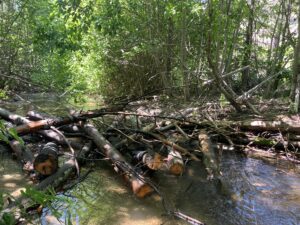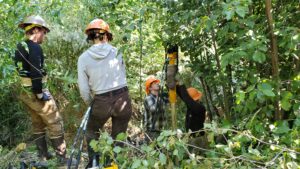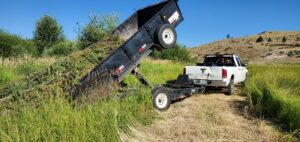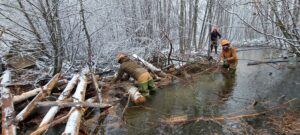In addition to promoting the incredible ecosystem benefits of beavers, Methow Okanogan Beaver Project conducts riparian restoration projects using a technique called Process-Based Restoration that mimics and restores dynamic watershed processes, including returning wood to streams and promoting beaver activity. Our restoration work helps reconnect degraded streams to their floodplains, restore fish and wildlife habitat, and reestablish native plant communities. By jump-starting these processes, we prepare streams to support beavers who will take over our restoration work and rebuild climate resilience!
The Beaver-Watershed Connection
Beavers are ecosystem heroes. They create habitat for countless other species and keep watersheds resilient in the face of drought, flooding, and wildfire. Through their digging, tree-felling, and damming behaviors, beavers once moderated many of the processes that keep watersheds functional and dynamic. Yet during European colonization of North America, this keystone species was nearly hunted to extinction for political power and European fashion trends. While the fur trade is no longer a major threat to beavers, and their numbers have begun to recover, their populations remain low due to human priorities that manage them as a nuisance rather than a necessary partner in ecological function, watershed processes, and climate resilience. As a result, North American ecosystems have suffered. Prior to European colonization, riparian areas and wetlands are estimated to have covered 40-50% of the landscape of what is now the Western US, yet today they make up less than 2% of the West's landcover. The riparian areas and wetlands we have left are degraded and dysfunctional due to the impacts of beaver removal, mining, grazing, development, and resulting climate change. Streams and rivers have been oversimplified and disconnected from their floodplains by humans. They no longer provide ideal habitat for fish and wildlife nor resilience to a changing climate. Our watersheds are missing their keystone beavers.
That's where the Methow Okanogan Beaver Project comes in to help reconnect beavers and people to restore our watersheds together. Our stream restoration projects help slow water, trap sediment, and create complexity in stream systems without beavers, with the goal of re-establishing the strong plant communities and deep water pools necessary to support beavers and all freshwater-dependent species, including humans.
Restoration Techniques
MOBP practices a restoration technique called Low-Tech Process-Based Restoration. LTPBR strategies employ simple, inexpensive, and low-impact methods that work to restore dynamic natural process, rather than achieve a specific fixed outcome. Many LTPBR methods work by mimicking the influence of beavers on a landscape to add woody structure and complexity to streams, and to slow water and aggrade sediment, or raise stream beds, helping to reconnect floodplains during seasonal high flow events.
MOBP uses several techniques to mimic the actions of beavers and kickstart dynamic process in degraded stream systems, these include: building woody structures like Beaver Dam Analogues and Post-Assisted Log Structures, wood loading, and riparian planting.

Beaver Dam Analogues
Beaver Dam Analogues (BDAs) are essentially human-made beaver dams. We install BDAs in streams that have become deeply intrenched through human impacts such as post-wildfire debris flows or livestock use. These structures slow the flow of water and trap sediment, helping to build streams back up towards their floodplains. BDAs can also help filter pollutants and excessive nutrients out of streams.
Post-Assisted Log Structures
Post-Assisted Log Structures (PALS) are similar to BDAs, but rather than spanning across the entire stream-bed, they are anchored on one side or in the center of the stream, making them an ideal choice for streams where adult fish passage is a concern. PALS also help slow water, increase flow complexity, and provide native salmon refuge from predators and high flow conditions.

Wood Loading
Wood loading mimics the natural process of wood accumulation in streams. MOBP creates wood jams out of small wood found on site. These wood jams are naturally dynamic, shifting and changing throughout the season to provide habitat, structure and complexity in degraded streams and act as speed-bumps to slow water down and prevent erosion.
Riparian Planting
MOBP plants native plants in riparian corridors around our stream restoration projects to restore habitat for other native species and provide a tasty food source for beavers. Riparian planting can also be considered a beaver-mimicry technique, as beaver activity helps stimulate new plant growth in species like willow, aspen, cottonwood.
Beaver Relocation
Repopulating an area with beavers is a restoration strategy in-and-of itself! Beavers are watershed-restoration experts, and reintroducing them to a landscape has many benefits: from improved complex and dynamic fish and wildlife habitat, to better floodplain connection, to more abundant and resilient native plant communities. Beaver relocation can be a humane and effective standalone restoration strategy, or it can be paired with Low-Tech Process-Based restoration techniques as described above.
Methow Okanogan Beaver Project works in many streams that are so degraded they don't have the deep pools and abundant plant communities needed to support beaver re-establishment. In many cases, beaver relocation would not be very effective as a standalone restoration strategy. Instead, we use techniques like BDA-building, wood-loading, and riparian planting to help kickstart ecological function, and rebuild the conditions that beavers need. When ready, and when an irreconcilable beaver conflict requires relocation, these restoration sites provide a great new home for beavers and allow transition of our stream restoration projects over to beavers' expert management.
To learn more about relocation, visit our beaver relocation page.








